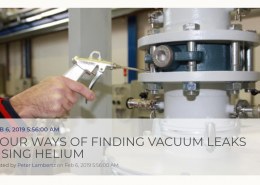Finding leaks in vacuum furnaces is a task that few people look forward to, however it is important and necessary. Leaks happen almost always and can occur suddenly or develop over time. They can damage both the material being heat treated as well as internal furnace components. When left uncheckedRead more
Finding leaks in vacuum furnaces is a task that few people look forward to, however it is important and necessary. Leaks happen almost always and can occur suddenly or develop over time. They can damage both the material being heat treated as well as internal furnace components. When left unchecked leaks will stop the furnace from pumping down and will compromise the heating elements. Small leaks often go undetected since the pumping system can overcome them, but they can still cause continuous and eventually catastrophic damage. It is therefore highly recommended that routine leak checking and repair be a part of any good preventative furnace maintenance program.
An Excerpt: “Why is helium used to detect leaks? Helium is used as a tracer gas to detect leaks for several reasons. These include the fact that it constitutes only ~ 5 ppm in air so that background levels are very low. Helium has also relatively low mass so that it is ‘mobile’ and is completely inert/non-reactive. Helium is also non-flammable and generally widely available and low cost. This association with helium is one of the reasons why one of the most accurate and rapid leak detection methods employs helium as the tracer gas and a mass spectrometer for the analyzing/measuring. Furthermore, helium is chosen as a tracer gas because it is light, very quick, and absolutely harmless.” >> Continue Reading
See less

Nitrogen and helium leak testing are both methods used to detect leaks in vacuum systems, such as vacuum furnaces, but they operate on different principles and have different applications based on their properties. Nitrogen Leak Testing: 1. Inertness: Nitrogen is an inert gas, which means it does noRead more
Nitrogen and helium leak testing are both methods used to detect leaks in vacuum systems, such as vacuum furnaces, but they operate on different principles and have different applications based on their properties.
Nitrogen Leak Testing:
1. Inertness: Nitrogen is an inert gas, which means it does not react with most materials. This property is beneficial when testing systems that might be reactive to other gases.
2. Molecular Size: Nitrogen molecules are larger than helium molecules. This can make nitrogen less effective at finding very small leaks since larger molecules may not escape through the smallest of openings.
3. Availability and Cost: Nitrogen is more readily available and is less expensive than helium, making it a more cost-effective option for some leak testing scenarios.
4. Method: Nitrogen leak testing typically involves pressurizing the system with nitrogen and using methods like a pressure decay test to detect if there is a loss of pressure indicative of a leak.
Helium Leak Testing:
1. Sensitivity: Helium is a much smaller molecule than nitrogen, which allows it to escape through smaller leaks. This makes helium leak testing more sensitive and able to detect very small leaks.
2. Detection Method: Helium leak detectors, known as mass spectrometers, can detect helium molecules in a vacuum down to very low concentrations, making it possible to find very small leaks.
3. Cost: Helium is generally more expensive and less abundant than nitrogen, which can make helium leak testing more costly.
4. Non-Reactive: Like nitrogen, helium is also a noble gas and is non-reactive, which is beneficial when testing in sensitive environments.
In a vacuum furnace, helium leak testing is often preferred due to its high sensitivity and ability to detect very small leaks. This is critical in vacuum applications where even tiny leaks can significantly affect the process or the quality of the products being treated. However, for larger leaks or when cost is a significant factor, nitrogen may be used initially to identify obvious leaks before switching to the more expensive helium testing for fine leak detection.
See less